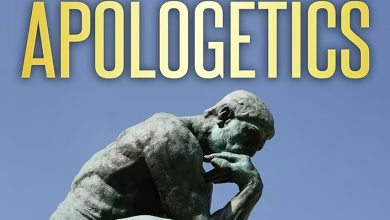الرد على تناقض في موعد التجلي، هل كان بعد 6 أم 8 أيام؟
الرد على تناقض في موعد التجلي، هل كان بعد 6 أم 8 أيام؟

لا أعلم كم من المرات علينا أن نقوم بالرد على ذات الشبهات! بل ولا أعلم لماذا لا يبحث طارح الشبهة عن تفسير قبلما يطرح كلامه كأنه شبهة! إلى متى سنظل نعلمهم كيف ومتى يعودون للكتب لكي تخبرهم بما لم يفهموه، كما ترون، هذه الشبهة القديمة الساذجة جداً يطرحها شخص هو عند القوم من كبارهم (ولا أعلم لماذا)!، فعلى كلٍ سنرد على الشبهة سريعاً نظراً لتفاهتها وتهافتها…
الرد بإختصار، أن كل من القديس متى ومرقس قد وضعاً الستة أيام الموجودة بين يوم كلام المسيح الذي إنتهى في (مت 16: 28، مر 9: 1) وبين يوم التجلي نفسه بدون أن يدخلوا هذا اليوم ولا ذاك في الحسبان، أي انهم قد حسبوا الأيام الواقعة بين هذين اليومين، وأما القديس لوقا فقد حسب هذه الستة أيام ولكن أضاف لها يوم إنتهاء كلام المسيح ويوم التجلي نفسه، أي أن كل ما في الأمر هو من أين بدأ وإنتهى كل بشير من الثلاثة، ومعروف عند اليهود ان جزء من اليوم يعتبر يوما كاملاً، فأين التناقض؟
هذا بالإضافة إلى أن القديس لوقا قال “بنحو ὡσεὶ“، فحتى لو إفترضنا جدلا أن الرد الموجود أعلاه غير صحيح لأي سبب، فلا يمكن أيضا أن يكون هذا تناقض بسبب هذه الكلمة إذ أنه وضع الفترة التقريبية.. فأين التناقض؟
يقول John A. Martin:
About eight days later Jesus . . . took three of His apostles up onto a mountain to pray. But Mark wrote that the event occurred after six days (Mark 9:2). The two accounts are not contradictory if one understands Mark as speaking of the intervening days and Luke as including the days of Jesus’ teaching as well as the day on which the transfiguration took place.[1]
يقول Adam Clarke:
After six days] Mr 9:2, has the same number; but Luke says, Lu 9:28, after eight days. The reason of this difference seems to be the following: Matthew and Mark reckon the days from that mentioned in the preceding chapter, to that mentioned in this; Luke includes both days, as well as the six intermediate: hence, the one makes eight, the other six, without any contradiction.[2]
يقول J. J. VAN OOSTERZEE:
Eight days.—According to Matthew and Mark, six days after the just-mentioned conversation. If we assure that Lake has reckoned in the day of the discourse and a second day for the Transfiguration, which had perhaps already taken place in the morning, the difference is then almost reconciled, and it does not even need the assumption of some, that the Saviour spent one or two whole days on the mountain, the Transfiguration taking place after their expiration.[3]
يقول David Brown :
an eight days after these sayings—including the day on which this was spoken and that of the Transfiguration. Matthew and Mark say (Mt 17:1; Mk 9:2) “after six days,” excluding these two days.[4]
يقول Richard C. Blight :
What period of time is indicated by the phrase ‘about eight days’?
In Matthew 17:1 and Mark 9:2 the time is given as ‘after six days’, which was the exact interval [BECNT, Lns] and this agrees with ‘about’ eight days [ICC]. ‘Eight days’ may be a rounded-off number and mean ‘about a week later’ [AB, NIC, TG, TH, WBC] while Matthew and Mark give the exact time [NIC]. Perhaps Luke included the day of Peter’s confession and the day of the transfiguration while Matthew and Mark referred to only the intervening days [Alf, Crd, NIC, NIGTC, NTC].[5]
يقول Jimmy Swaggart :
The phrase, “And it came to pass about an eight days after these sayings,” has Mark saying “six days” (Mk. 9:2). There is no discrepancy.
The phrase in Mark is exclusive, which means all the days and time are not included in the statement.
In Luke the Greek phrase is inclusive, meaning that two more days of time elements were counted which Matthew and Mark did not include.[6]
يقول New Living Translation Study Bible :
About eight days later: Mark says “after six days,” referring to full days, while Luke includes parts of days.[7]
يقول The Pulpit Commentary :
Matthew and Mark speak only of six days. St. Luke gives the period in round numbers, counting portions of the first and last days as whole days.[8]
يقول Charles Caldwell Ryrie :
after six days. Luke’s “about eight days” includes the beginning and ending days as well as the interval between. Peter, James, and John. The inner circle of the disciples.[9]
لو كان المعترض قد قرأ في التفاسير لكان وجد، لكن ما أسهل أن يلقي بالشبهات، ربما حتى لو عرف أنها غير صحيحة!
[1]Walvoord, J. F., Zuck, R. B., & Dallas Theological Seminary. 1983-c1985. The Bible knowledge commentary : An exposition of the scriptures (2:230). Victor Books: Wheaton, IL
[2]Clarke, A. 1999. Clarke’s Commentary: Matthew (electronic ed.). Logos Library System; Clarke’s Commentaries (Mt 17:1). Ages Software: Albany, OR
[3]Lange, J. P., Schaff, P., van Oosterzee, J. J., & Starbuck, C. C. 2008. A commentary on the Holy Scriptures : Luke (152). Logos Research Systems, Inc.: Bellingham, WA
[4]Jamieson, R., Fausset, A. R., Fausset, A. R., Brown, D., & Brown, D. 1997. A commentary, critical and explanatory, on the Old and New Testaments. On spine: Critical and explanatory commentary. (Lk 9:28). Logos Research Systems, Inc.: Oak Harbor, WA
BECNT Bock, Darrell L. Luke. 2 vols. Baker Exegetical Commentary on the New Testament. Grand Rapids: Baker Books, 1994 and 1996.
Lns Lenski, R. C. H. The Interpretation of St. Luke’s Gospel. Minneapolis: Augsburg, 1946.
ICC Plummer, Alfred. A Critical and Exegetical Commentary on the Gospel According to S. Luke. The International Critical Commentary. Edinburgh: T. & T. Clark, 1896.
AB Fitzmyer, Jospeph A. The Gospel According to Luke. 2 vols. Garden City, N.Y.: Doubleday, 1981 and 1985.
NIC Geldenhuys, Norval. Commentary on the Gospel of Luke. New International Commentary on the New Testament. Grand Rapids: Eerdmans, 1951.
TG Bratcher, Robert G. A Translator’s Guide to the Gospel of Luke. London, New York: United Bible Societies, 1982.
TH Reiline, J., and J. L. Swellengrebel. A Handbook on The Gospel of Luke. New York: United Bible Societies, 1971.
WBC Nolland, John. Luke. 3 vols. Word Biblical Commentary. Dallas: Word Books, 1989 and 1993.
Alf Alford, Henry. The Four Gospels. The Greek Testament, vol. 1. 1874. Reprint. Chicago: Moody, 1968.
Crd Creed, John Martin. The Gospel According to St. Luke. London: MacMillan, 1930.
NIGTC Marshall, I. Howard. The Gospel of Luke. The New International Greek Testament Commentary. Grand Rapids: Eerdmans, 1978.
NTC Hendriksen, William. Exposition of the Gospel According to Luke. New Testament Commentary. Grand Rapids: Baker, 1978.
[5]Blight, R. C. 2008. An Exegetical Summary of Luke 1-11 (2nd ed.) (410). SIL International: Dallas, TX
[6]Swaggart, J. 1996. Jimmy Swaggart Bible Commentary: Luke (264). World Evangelism Press: Baton Rouge, LA
[7]New Living Translation Study Bible. 2008 (Lk 9:28). Tyndale House Publishers, Inc.: Carol Stream, IL
[8]The Pulpit Commentary: St. Luke Vol. 2004 (H. D. M. Spence-Jones, Ed.) (238). Logos Research Systems, Inc.: Bellingham, WA
[9]Ryrie, C. C. 1994. Ryrie study Bible: King James Version (Expanded ed.) (1449). Moody Press: Chicago.


